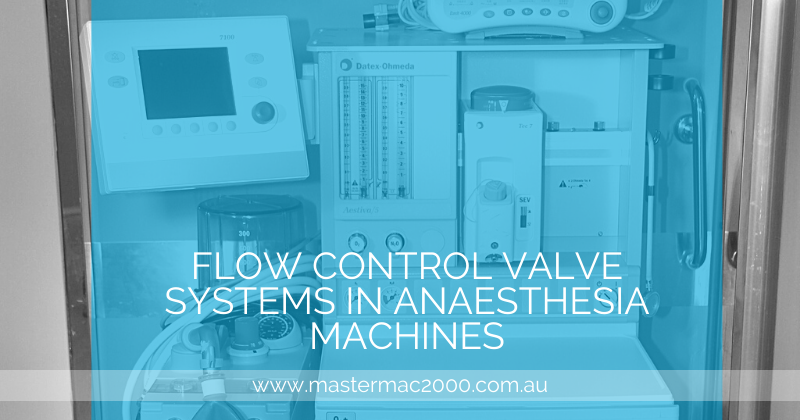Flow Control Valve Systems in Anaesthesia Machines

When talking about a flow control valve, people tend to think of large water production plants or electricity plants that use flow control valves and other pneumatic valves. But not many people know that different types of pneumatic valves are used in anaesthesia machines.
Anaesthesia is a sub-specialty in medicine that has adapted technology to improve performance and patient safety. Anaesthesia machines have come a long way from the time WTG Morton discovered that ether could be used as general anaesthesia in 1846 and HEG Boyle developed the patented British Oxygen Company’s ‘Boyle’s Machine.’
How an Anaesthesia Machine Works
The function of an anaesthesia machine is to deliver a precise and variable gas mixture, including anaesthetising and life-sustaining gasses at a controlled and known pressure. There are actually two methods to deliver anaesthesia:
- Intermittent – Delivered by an Entonox apparatus, gas flow is delivered only during inspiration.
- Continuous – Delivered by a Boyle’s machine, gas flow is delivered both during inspiration and expiration.
System components consist of:
- Electrical system – Master switch, Battery back-up, Battery recharge, Electric outlet for the in-built monitor, circuit breaker.
- Pneumatic system – High-pressure system, Intermediate pressure system, Low-pressure system.
When anaesthesia is delivered, four essential functions are performed:
- Providing dioxygen (oxygen).
- Accurately mix anaesthetic gases and vapours.
- Enables patient ventilation.
- Minimises anaesthesia related risks to patients as well as staff.
The basic design of a continuous anaesthesia or Boyle’s machine consists of pressurised gasses supplied by cylinders or pipelines to the anaesthetic machine. This controls the flow of gasses before passing them through a vapouriser and delivering the resulting mixture to the patient through the breathing apparatus circuit.
Importance of the Flowmeters
Flowmeters are part of the low-pressure system (the most common type of pneumatic system for anaesthesia machines) that consists of the flow control valve, vapouriser, one-way valves, and the common gas outlet.
The flow control valve is the thing attached to the knob that is turned to adjust the flow through the flowmeters. On most anaesthesia machines, flow control still uses a mechanical valve that is directly attached to one of the three knobs used to manipulate the flowmeters. The more modern machines coming out recently now use electronic controls as the interface between the operator and the flowmeters.
Master Mac 2000
The use of a pneumatic and flow control valve system in medical anaesthesia machines show the importance of pneumatic and process automation systems in all types of industries, including the medical and science sectors. So, when it comes to pneumatic systems, parts, and components, you can trust MasterMac2000 to provide quality brands such as Univer, Mack, Tolomatic, and others, including hard-to-get parts. MasterMac2000 has been an Australian-owned distributor since 1989 and is now one of the largest pneumatic distribution companies in Australia. Call them at 07 3344 4711 or visit https://mastermac2000.com.au/ for your industrial pneumatic valve needs.

About MasterMac2000: Your Trusted Pneumatic & Process Automation Partner.
LEADING THE INDUSTRY: Established in 1989, MasterMac2000 has grown to become one of Australia's largest privately owned pneumatic and process automation companies. We stock top-quality brands like Univer, Mack, Tolomatic, Mac, Piab, American, and Rotoflux in Brisbane.
SERVING QLD & NORTHERN NSW: We proudly service Queensland and Northern New South Wales for all your pneumatic and process equipment needs. Our mission is to provide the best pre and post-sales support while actively expanding our client base.
SOURCING HARD-TO-FIND PARTS: Not only do we stock quality components, but we also excel at sourcing those elusive, hard-to-find parts. With our extensive database and global network of contacts, getting the parts you require is as easy as a call to our highly skilled, professional sales team.
DEDICATED TO YOUR SUCCESS:
- Decades of expertise in pneumatics & process automation
- Carefully curated selection of world-class brands
- Exceptional sourcing capabilities for speciality parts
- Knowledgeable sales staff dedicated to finding solutions
- Unwavering commitment to customer service excellence
About The Author
Stuart Havill
Stuart Havill is the owner and manager of MasterMac2000, Queensland's largest privately owned pneumatic and process valve company.
With his early working career as a maintenance fitter for Boral in 1992, Stuart has spent his life in the field of pneumatics and process equipment. He gained extensive experience in plant design, maintenance, repairs, fabrication, and site management.
In 1996, he transitioned to a pneumatic sales technician role at MasterMac2000, where he excelled in key account management, providing cost-effective solutions, and managing a sales team of 9 employees.
Since 2002, Stuart has been the manager at MasterMac2000, overseeing the company's growth and establishing it as a leader in pneumatic automation and process valve engineering. His expertise spans customer training, CRM setup, industrial compressor sizing and installation, and turn-key project management.
Under Stuart's leadership, MasterMac2000 has been servicing the industry since 1988, with 5 full-time sales representatives covering northern rivers NSW, Queensland, Northern Territory, and PNG. The company prides itself on providing the best-priced solutions to all customers in the marketplace.
View Stuart’s LinkedIn profile to learn more about his expertise in pneumatics and process equipment.